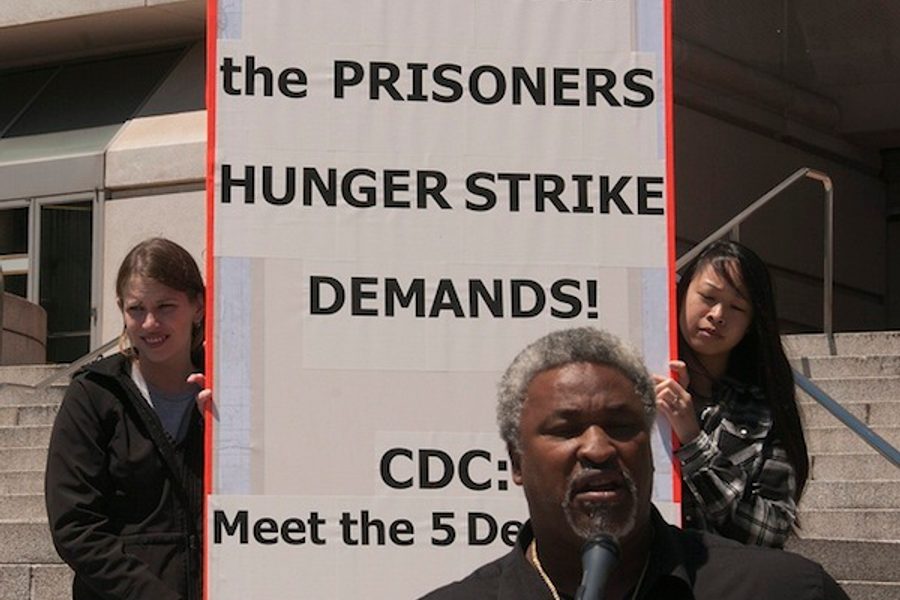
“If CDCR [California Department of Corrections and Rehabilitation] officials do not sign off on our five core demands I will end up in a hospital on a feeding tube or dead,” writes Paul Redd, on the back of a postcard with a photograph of Golden Gate Bridge at sunset. Redd, an inmate at Pelican Bay State Prison, is of 1,457 prisoners in 15 California prisons who are on hunger strike to demand an end to long-term solitary confinement, which they call “torture.”
Hunger strikers and their supporters have accused the CDCR of “retaliating” against the protest. On July 11, four days into the strike, 14 prisoners in Pelican Bay, including Redd, were moved to Administrative Segregation Units, an even more extreme form of segregation used to punish those who have broken prison rules. In a written statement, prisoners in Pelican Bay said they were being “subjected to more torturous conditions than in the SHU [Security Housing Unit].” Prisoners called the transfer a “diabolical act” and an attempt to “break our resolve and hasten our deaths.”
In what advocates say is a further attempt to break the strike, Marilyn McMahon, executive director of California Prison Focus, a prisoner advocacy group, was banned by the CDCR from visiting her clients in Pelican Bay. The exclusion order bans her from the prison pending an investigation to determine whether one of her legal assistants “presents a serious threat to security.” It does not say what the threat is believed to be. McMahon was also banned from the prison during the last hunger strike, in 2011.
Following that hunger strike, the department agreed to review the cases of all prisoners in solitary. Before this hunger strike started, the state said it had reviewed 382 cases, and moved 208 prisoners back into the general population. Last week, corrections secretary Jeffrey Beard announced that the review process would be suspended as a result of the protest.
One of the main demands by the strikers is to change the way in which prisoners are labeled as gang members or associates (alleged prison gang associations are one of the main reasons prisoners are assigned to solitary confinement). In particular, they want to end the requirement for prisoners to inform on other prisoners in order to be freed from solitary, a process known as “debriefing.” Information from prisoners who debrief is often used to sentence others to SHU.
While the department has categorized him as a gang member, Paul Redd says he is actually being kept in solitary because of his work as a jailhouse lawyer. He has now been held in solitary confinement for more than 30 years.
In a letter from inside Pelican Bay, Kijana Tashiri Askari says he has also been targeted “in retaliation for my political beliefs/ activities, and jailhouse lawyering.” He accuses prison officials of “psychological warfare” and says that in solitary, prisoners avoid speaking languages other than English because these might be deemed “gang related.” Askari, who identifies as New Afrikan, says prison officials prevent prisoners from “studying, reading, and writing about our political social and cultural history, as it is considered a form of gang activity.” Prisoners have even expressed concerns that participation in the hunger strike could itself be grounds for being “validated” as a gang member or associate.
Corrections officials are treating the hunger strike as a “disturbance” organized by prison gangs. “We have had a few reports of inmates being pressured or coerced into participating in this disruptive activity,” says Terry Thornton, a spokesperson for the corrections department. She says that the Security Housing Units are necessary to disrupt gang activity in prison. “The whole purpose of separating these inmates from general population inmates [is] so they don’t influence and coerce them,” she says. According to Thornton, gang violence is “an issue this department has been dealing with for decades.”
But Dr. Terry Kupers, a psychiatrist who has testified as an expert witness in several court cases against the state, says that the department’s approach is misguided. According to Kupers, the real reason for violence in California’s prisons is overcrowding — an issue that the department has struggled with for years. “It cannot be shown that the existence of SHUs in any way positively affects the violence rates in the prison,” says Kupers, “whereas it greatly damages the mental health of prisoners”.
As the hunger strike continues, concerns are growing for the health of the prisoners. California Correctional Healthcare Services says medical staff have carried out checks on all prisoners currently refusing food. Elizabeth Gransee, a spokesperson for the department, says that if prisoners show signs of distress, prison officials “may refer them to their primary care physician.” Gransee says no prisoners are currently at that stage. However, several prisoners have reported having their medication cut off. According to Marilyn McMahon, pain relief medication in particular is being withheld, “even if it’s medicine that should not be cut abruptly, but instead tapered off.” She says that one prisoner “was told that his medicine was cut because it can’t be taken if he’s dehydrated, but he is drinking lots of water while on hunger strike, so dehydration is not a danger.” Gransee says that if medication is being adjusted, it is for medical reasons only. “There’s no retaliation there,” she says.
In his letter, Kijana Askari says that in his view, the purpose of solitary confinement is to “break prisoners mentally, emotionally, spiritually.” After 12 days on hunger strike, prisoners say that the Corrections Department is trying to break their strike as well. In their statement, the hunger strike representatives in Pelican Bay say they remain “100% committed” to their protest. Askari says that he joined the hunger strike because after 19 years in isolation, “I simply refuse to be tortured and be silent about it any longer.”

